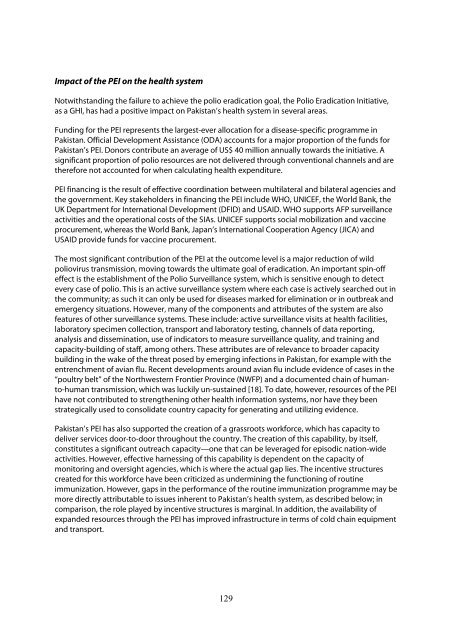MAXIMIZING POSITIVE SYNERGIES - World Health Organization
MAXIMIZING POSITIVE SYNERGIES - World Health Organization
MAXIMIZING POSITIVE SYNERGIES - World Health Organization
You also want an ePaper? Increase the reach of your titles
YUMPU automatically turns print PDFs into web optimized ePapers that Google loves.
Impact of the PEI on the health system<br />
Notwithstanding the failure to achieve the polio eradication goal, the Polio Eradication Initiative,<br />
as a GHI, has had a positive impact on Pakistan’s health system in several areas.<br />
Funding for the PEI represents the largest-ever allocation for a disease-specific programme in<br />
Pakistan. Official Development Assistance (ODA) accounts for a major proportion of the funds for<br />
Pakistan’s PEI. Donors contribute an average of US$ 40 million annually towards the initiative. A<br />
significant proportion of polio resources are not delivered through conventional channels and are<br />
therefore not accounted for when calculating health expenditure.<br />
PEI financing is the result of effective coordination between multilateral and bilateral agencies and<br />
the government. Key stakeholders in financing the PEI include WHO, UNICEF, the <strong>World</strong> Bank, the<br />
UK Department for International Development (DFID) and USAID. WHO supports AFP surveillance<br />
activities and the operational costs of the SIAs. UNICEF supports social mobilization and vaccine<br />
procurement, whereas the <strong>World</strong> Bank, Japan’s International Cooperation Agency (JICA) and<br />
USAID provide funds for vaccine procurement.<br />
The most significant contribution of the PEI at the outcome level is a major reduction of wild<br />
poliovirus transmission, moving towards the ultimate goal of eradication. An important spin-off<br />
effect is the establishment of the Polio Surveillance system, which is sensitive enough to detect<br />
every case of polio. This is an active surveillance system where each case is actively searched out in<br />
the community; as such it can only be used for diseases marked for elimination or in outbreak and<br />
emergency situations. However, many of the components and attributes of the system are also<br />
features of other surveillance systems. These include: active surveillance visits at health facilities,<br />
laboratory specimen collection, transport and laboratory testing, channels of data reporting,<br />
analysis and dissemination, use of indicators to measure surveillance quality, and training and<br />
capacity-building of staff, among others. These attributes are of relevance to broader capacity<br />
building in the wake of the threat posed by emerging infections in Pakistan, for example with the<br />
entrenchment of avian flu. Recent developments around avian flu include evidence of cases in the<br />
“poultry belt” of the Northwestern Frontier Province (NWFP) and a documented chain of humanto-human<br />
transmission, which was luckily un-sustained [18]. To date, however, resources of the PEI<br />
have not contributed to strengthening other health information systems, nor have they been<br />
strategically used to consolidate country capacity for generating and utilizing evidence.<br />
Pakistan’s PEI has also supported the creation of a grassroots workforce, which has capacity to<br />
deliver services door-to-door throughout the country. The creation of this capability, by itself,<br />
constitutes a significant outreach capacity—one that can be leveraged for episodic nation-wide<br />
activities. However, effective harnessing of this capability is dependent on the capacity of<br />
monitoring and oversight agencies, which is where the actual gap lies. The incentive structures<br />
created for this workforce have been criticized as undermining the functioning of routine<br />
immunization. However, gaps in the performance of the routine immunization programme may be<br />
more directly attributable to issues inherent to Pakistan’s health system, as described below; in<br />
comparison, the role played by incentive structures is marginal. In addition, the availability of<br />
expanded resources through the PEI has improved infrastructure in terms of cold chain equipment<br />
and transport.<br />
129

















